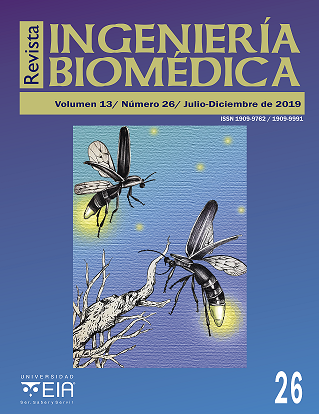Polimorfismos de inserción de elementos transponibles ligados a cancer de mama: una prueba de concepto
Transposable Elements Insertion Polymorphisms Linked To Breast Cancer: A Proof Of Concept
Barra lateral del artículo
Licencia
![]()
Esta obra está bajo una Licencia Creative Commons Atribución-NoComercial-NoDerivativa 4.0 Internacional
Contenido principal del artículo
Resumen
Los retrovirus endógenos humanos (HERVs) constituyen aproximadamente el 8% del genoma humano, particularmente están sobreexpresados en algunas células y tejidos del carcinoma de mama que es el más común y la segunda causa de muerte por cáncer en mujeres en todo el mundo. Investigaciones recientes muestran que la familia de retrovirus HERV-K es la de más expresión génica sobre el cáncer de mama. Los elementos HERV-K 108, 109, 113 y 115 son los más encontrados en esta enfermedad, y que, además, se sabe están ubicados a nivel genómico en el cromosoma 6, 7, 8, y 19 respectivamente. La liberación de datos genómicos de pacientes patológicamente identificados con esta enfermedad, ha permitido avances en aspectos de origen, desarrollo y diagnóstico. Dado esto, se plantea la siguiente investigación enfocada en encontrar nuevos polimorfismos de inserción que puedan estar ligados a cáncer de mama, a través de TRACKPOSON, un software diseñado para la detección de polimorfismos de inserción de elementos transponibles (TIPs). Este pipeline fue utilizado en 3000 genomas de arroz, pero su funcionalidad fue extrapolada a este proyecto usando un genoma humano sano (de referencia), una base de datos de HERVs y lecturas de secuenciación del genoma de pacientes enfermos (tecnología Illumina). Finalmente, los resultados obtenidos in silico arrojan TIPs asociados a cáncer de mama con su ubicación cromosómica, especialmente en el cromosoma 8. Destacamos entonces que este “mimetismo bioinformático”, podría ofrecer mejora en los métodos de investigación y de enfoque diagnóstico de esta enfermedad.
Descargas
Detalles del artículo
Nicolas Tobon Orozco, Universidad Autonoma de Manizales
Estudiante de ingeniería biomédica e ingerniería electrónica, facultad de ingeniería Universidad Autónoma de Manizales.Referencias (VER)
O. Ridge, J. Genetics, L. Cells, J. Reed, M. Lefort, y E. Sgourakis, “(or recognition)”, 1950.
G. Bourque et al., “Ten things you should know about transposable elements”, pp. 1–12, 2018.
R. P. Subramanian, J. H. Wildschutte, C. Russo, y J. M. Coffin, “Identification , characterization , and comparative genomic distribution of the HERV-K ( HML-2 ) group of human endogenous retroviruses”, pp. 1–22, 2011.
E. R. Havecker, X. Gao, y D. F. Voytas, “The diversity of LTR retrotransposons”, 2004.
M. Zhang y J. Q. Liang, “Expressional activation and functional roles of human endogenous retroviruses in cancers”, núm. November 2018, pp. 1–11, 2019.
A. Roesch, E. Meese, J. Mayer, y K. Schmitt, “Transcriptional Profiling of Human Endogenous Retrovirus Group HERV-K ( HML-2 ) Loci in Melanoma”, vol. 5, núm. 2, pp. 307–328, 2013.
W. Goering, K. Schmitt, M. Dostert, H. Schaal, J. Mayer, y W. A. Schulz, “Human Endogenous Retrovirus HERV-K ( HML-2 ) Activity in Prostate Cancer Is Dominated by a Few Loci”, vol. 1971, núm. September, pp. 1958–1971, 2015.
M. Li et al., “Downregulation of Human Endogenous Retrovirus Type K ( HERV-K ) Viral env RNA in Pancreatic Cancer Cells Decreases Cell Proliferation and Tumor Growth”, vol. 23, núm. 43, 2017.
G. L. Johanning, G. G. Malouf, X. Zheng, y F. J. Esteva, “Expression of human endogenous retrovirus-K is strongly associated with the basal-like breast cancer phenotype”, Nat. Publ. Gr., núm. August 2016, pp. 1–11, 2017.
L. Cegolon, C. Salata, E. Weiderpass, P. Vineis, G. Palù, y G. Mastrangelo, “Human endogenous retroviruses and cancer prevention : evidence and prospects”, 2013.
C. E. Desantis, “Breast Cancer Statistics , 2017 , Racial Disparity in Mortality by State”, vol. 67, núm. 6, pp. 439–448, 2017.
E. Hénaff, L. Zapata, J. M. Casacuberta, y S. Ossowski, “Jitterbug : somatic and germline transposon insertion detection at single-nucleotide resolution”, BMC Genomics, pp. 1–16, 2015.
M. Carpentier et al., “Retrotranspositional landscape of Asian rice revealed by 3000 genomes”, Nat. Commun., núm. 2019.
N. Bannert, H. Hofmann, A. Block, y O. Hohn, “HERVs New Role in Cancer : From Accused Perpetrators to Cheerful Protectors”, vol. 9, núm. February, pp. 1–8, 2018.
X. Chen, “Understanding the genetic architecture of schizophrenia in Chinese population”.
B. Langmead y S. L. Salzberg, “Fast gapped-read alignment with Bowtie 2”, vol. 9, núm. 4, pp. 357–360, 2012.
H. Li et al., “The Sequence Alignment / Map format and SAMtools”, vol. 25, núm. 16, pp. 2078–2079, 2009.
A. R. Quinlan y I. M. Hall, “BEDTools : a flexible suite of utilities for comparing genomic features”, vol. 26, núm. 6, pp. 841–842, 2010.
S. F. Altschup, W. Gish, T. Pennsylvania, y U. Park, “Basic Local Alignment Search Tool 2Department of Computer Science”, pp. 403–410, 1990.
R. Contreras-galindo et al., “Human Endogenous Retrovirus K ( HML-2 ) Elements in the Plasma of People with Lymphoma and Breast Cancer ᰔ †”, vol. 82, núm. 19, pp. 9329–9336, 2008.
K. Ruprecht et al., “Human Endogenous Retrovirus Family HERV-K ( HML-2 ) RNA Transcripts Are Selectively Packaged into Retroviral Particles Produced by the Human Germ Cell Tumor Line Tera-1 and Originate Mainly from a Provirus on Chromosome 22q11 . 21 ᰔ †”, vol. 82, núm. 20, pp. 10008–10016, 2008.


 PDF
PDF
 FLIP
FLIP







